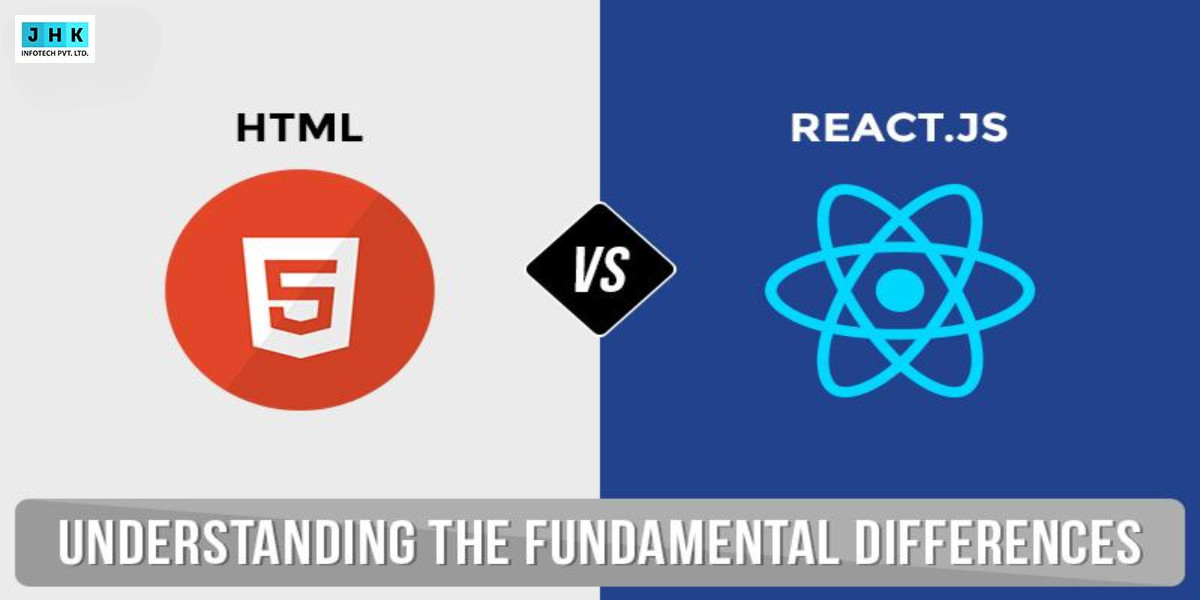HTML vs. React.js: Understanding the Fundamental Differences

In the world of web development, two fundamental building blocks are HTML (Hypertext Markup Language) and React.js. HTML has been around since the inception of the World Wide Web, whereas React.js is a more recent addition to the developer’s toolkit. In this blog post, we will explore the fundamental differences between HTML and React.js, their key features, and when to use each one.
HTML
What is HTML?
HTML is the standard markup language for creating web pages. It provides the basic structure and content of a web page. HTML documents consist of a series of elements, which are represented by tags, such as <html>, <head>, and <body>. These elements are used to structure content and provide semantic meaning to a web page.
Key Features of HTML
- Structure: HTML organizes content hierarchically with elements like headings, paragraphs, lists, and tables.
- Semantics: It allows you to define the meaning of content using tags like <article>, <header>, and <footer>.
- Static: HTML is a static markup language, which means that the content is displayed as-is, without interactivity.
React.js
What is React.js?
React.js, often referred to as React, is an open-source JavaScript library for building user interfaces. It was developed by Facebook and is maintained by a large community of developers. React allows developers to create reusable UI components that update efficiently when data changes. It is commonly used for single-page applications and mobile app development.
Key Features of React.js
- Component-Based: React follows a component-based architecture, where UI elements are encapsulated in reusable components.
- Virtual DOM: It employs a virtual representation of the DOM, which enhances performance by minimizing actual DOM manipulation.
- Declarative: React uses a declarative approach, making it easier to understand and debug your code.
- Interactive: React enables the creation of highly interactive user interfaces by handling state changes efficiently.
HTML: The Foundation of the Web
HTML is the backbone of the World Wide Web. It’s a markup language that defines the structure and content of web pages. Here are some key points about HTML:
- Static: HTML is a static language, which means that web pages created using HTML alone are not interactive. They display information as a set of static elements, such as headings, paragraphs, images, and links.
- Declarative: HTML is declarative in nature. You define the structure and content of your page, and the browser renders it accordingly. HTML elements consist of tags, attributes, and values that specify how content should be displayed.
- Logic: HTML offers minimal logic and no built-in functionality for handling dynamic content, making it suitable for basic web pages.
- Lightweight: HTML files are typically lightweight, as they only contain the essential elements needed to display content.
React.js: A JavaScript Library for Building User Interfaces
React.js, on the other hand, is a JavaScript library developed by Facebook. It’s designed for building dynamic and interactive user interfaces. Here’s what you need to know about React.js:
- Dynamic: React.js is a dynamic library that allows you to create highly interactive web applications. It enables you to update and render specific parts of a web page in response to user interactions.
- Component-Based: React.js follows a component-based architecture, where you build UIs using reusable components. This makes it easier to manage complex applications and maintain code.
- Virtual DOM: React.js utilizes a virtual DOM, which is a lightweight representation of the actual DOM. This improves performance by minimizing the need for full DOM updates when changes occur.
- Rich Ecosystem: React.js has a rich ecosystem of libraries, tools, and extensions that enhance its capabilities and simplify tasks like routing, state management, and form handling.
Looking for professional web design with optimized fonts and performance? Explore Our Web Development Services →
What Happened All of a Sudden?
If you’re new to web development or have been away from the field for a while, you might be wondering what’s changed so suddenly. The answer lies in the evolving landscape of web development. As user expectations have grown, web applications have become more interactive and responsive. This shift in demand has led to the emergence of JavaScript libraries and frameworks like React.js, which have significantly changed the way we create web applications.
Conclusion
The choice between HTML and React.js largely depends on the specific requirements of your web development project. Here’s a summary to help you make an informed decision:
Use HTML when:
- You need to create static web pages with minimal interactivity.
- Your project is simple and doesn’t require complex UI components.
- You want a lightweight and straightforward solution.
Use React.js when:
- Your project demands dynamic, highly interactive user interfaces.
- Component reusability and maintainability are essential.
- You want access to a wide range of community-supported tools and libraries.
FAQ’s
1. Difference between HTML code and React code
HTML is a markup language that defines the structure and layout of content on a webpage, whereas React is a JavaScript library designed to create dynamic, interactive user interfaces. In HTML, you write static code (, , ) to display content, whereas in React you use JSX (a mix of JavaScript and HTML-like syntax) along with components to create dynamic, reusable UI elements.
2. Is React or HTML better for beginners?
For beginners, HTML is the best starting point because it provides the foundation of web development. After learning HTML, CSS, and the basics of JavaScript, you can transition to React, which is more advanced and provides powerful tools for developing modern, interactive web applications.
3. Why use React over HTML?
You use React instead of plain HTML when you need:
- Dynamic content updates without refreshing the page.
- Reusable components that make development faster and cleaner.
- Better performance through Virtual DOM.
- Scalability for large web applications.
HTML alone cannot handle such advanced features, while React is designed to manage them efficiently.
4. What is React JS vs HTML?
React JS is a JavaScript library for building dynamic user interfaces, whereas HTML is a markup language used to create static webpage structures. You can think of HTML as the skeleton of a webpage, and React as the brain that makes it interactive and dynamic.
5. Why is React good for the front end?
React is excellent for front-end development because it:
- Provides fast rendering with Virtual DOM.
- Encourages component-based architecture for reusability.
- Works seamlessly with APIs and backends.
- Has a large ecosystem of tools and libraries.
- Backed by Facebook and a huge developer community, making it reliable and future-proof.
6. Which is more complicated, HTML or JavaScript?
JavaScript is more complicated than HTML.
- HTML is primarily about structure and markup (easy to learn and use).
- JavaScript introduces logic, interactivity, and functionality, requiring a solid understanding of programming concepts.
To master React, a solid grasp of JavaScript is essential, while HTML serves as the starting point.






